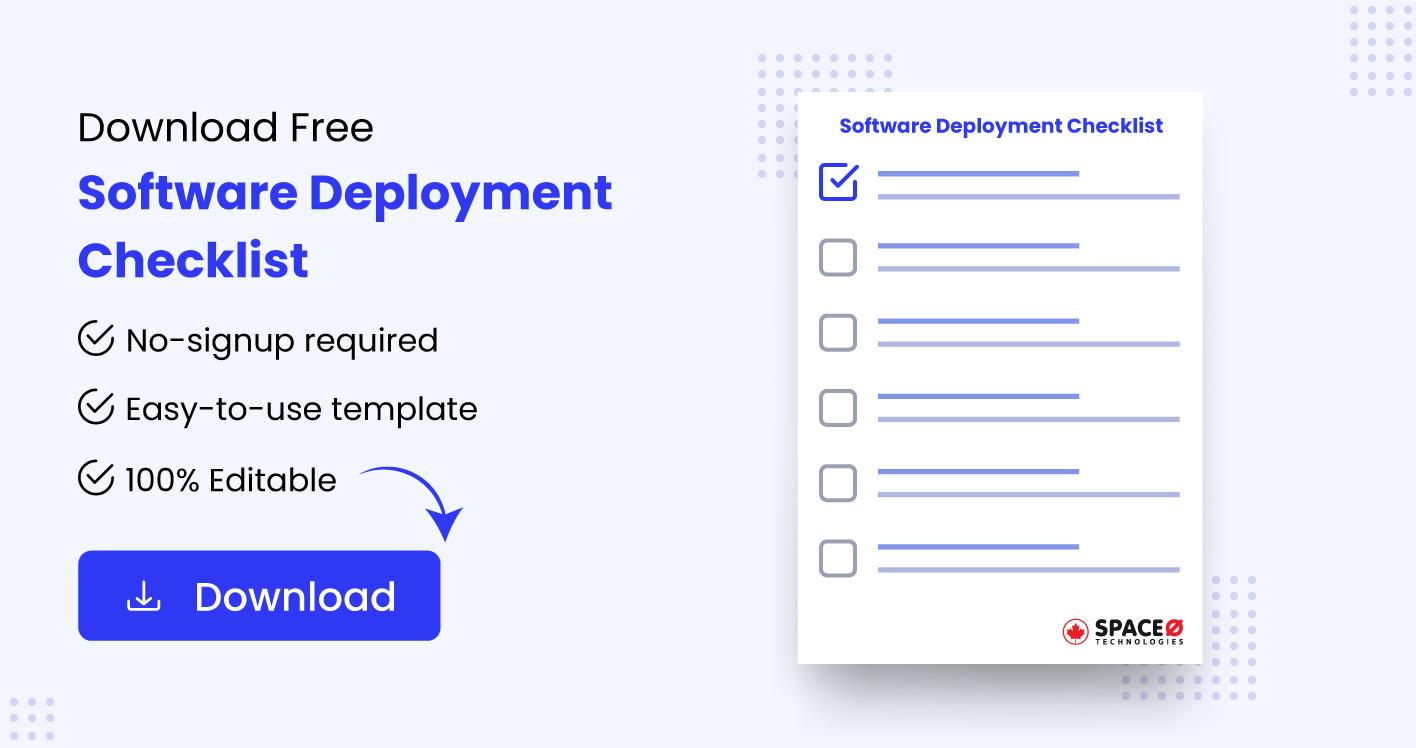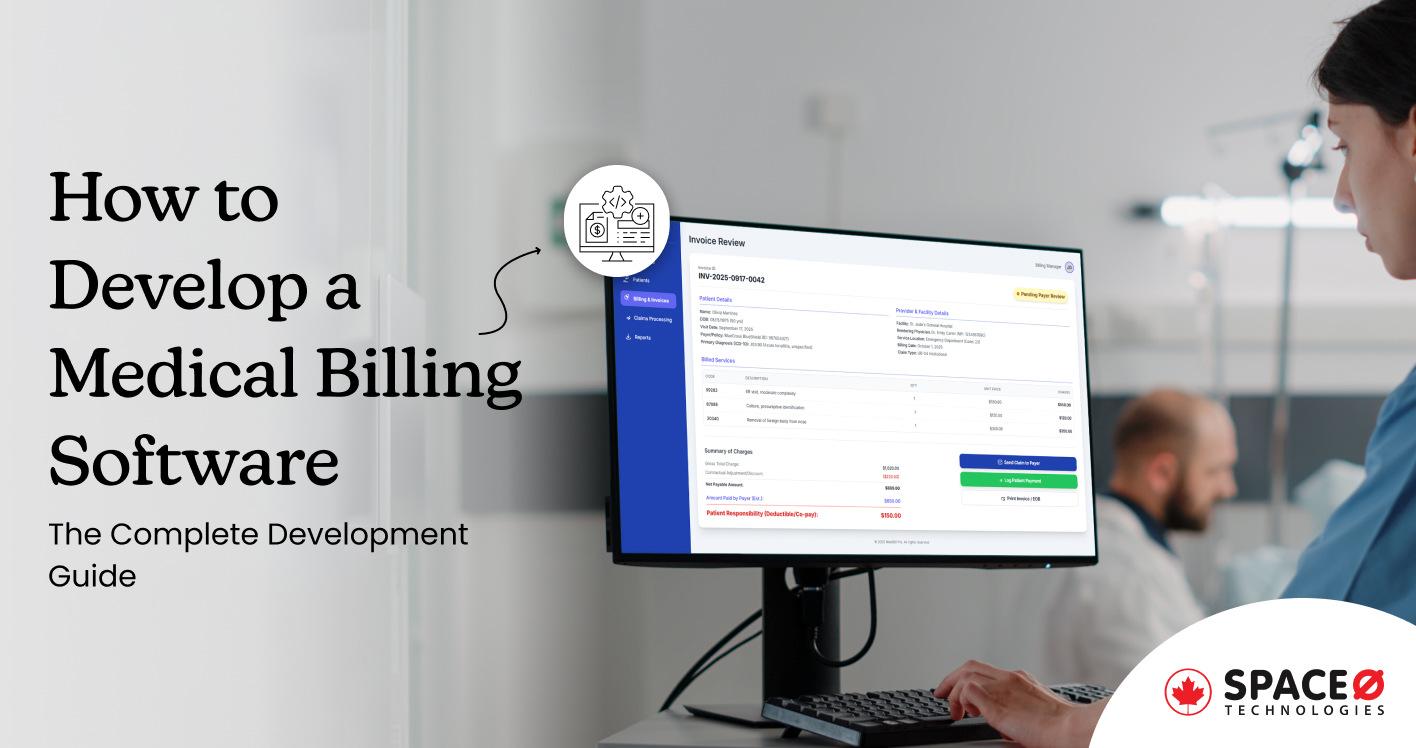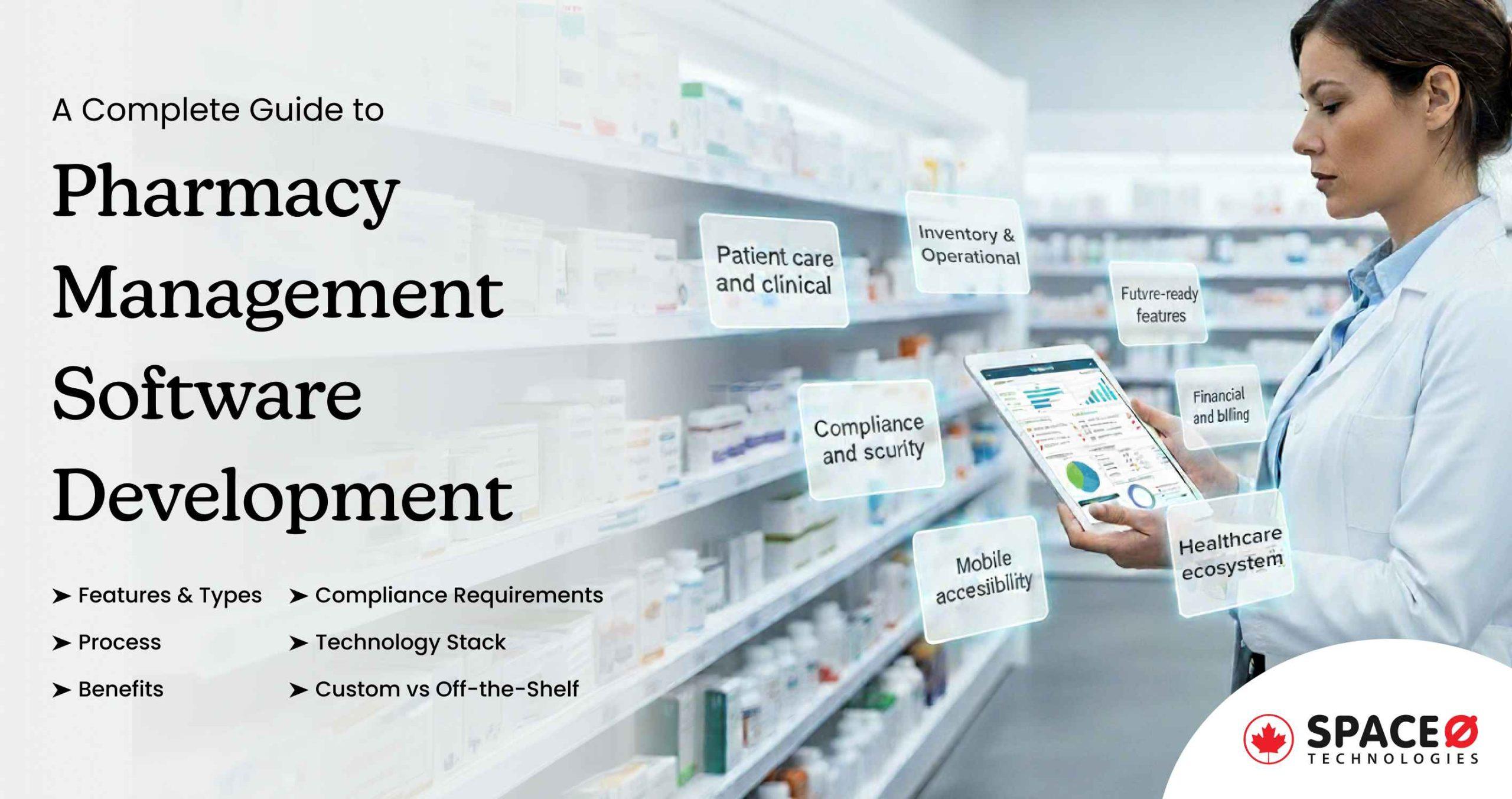
Software Deployment Checklist: Get Ready for Production
Deploying software in production environments is challenging. If you are unable to deploy software properly, there are chances of downtime and delays. Whether you are a project manager or lead software developer, managing the entire software deployment is tiring and complex.
There are multiple parts involved in the entire software deployment, such as dependency management, data migration, integration, disaster recovery management, and managing architectures. The combination of all these parts makes the process complex.
That’s where you need a plan. Using a comprehensive checklist helps you to every step of the software deployment in a smooth way.
As a top-tier custom software development firm, we know which points are important to check during pre-deployment, deployment, and post-deployment. So, we have provided a free software deployment checklist template to enhance and improve the efficiency of deployment.
Table of Contents
Get Your Free Software Deployment Checklist
Here is a checklist of software deployment you can use while executing deployment.
Pre-deployment Checklist
Deployment Checklist
Post-deployment Checklist
If you are looking to download a free software deployment checklist template, click on the following image. To use this checklist, make a copy of it in the Google Sheets. Now, you are ready to use this checklist and free to make changes as per your requirements.


5 Steps to Follow for the Software Deployment Process
Once your software is ready for deployment, a methodical approach is followed to ensure smooth execution. By understanding and executing a structured deployment process, you make sure transitions and minimal disruptions. Let’s learn a step-by-step process for successful software deployment within the development process.
Create a Plan for Your Software Development
When you are thinking of deploying your software, having a proper plan helps to execute a smooth and flawless deployment of your software solution. With a detailed plan, you achieve the expected results within the decided timeline without facing major problems.
What are the tools that help in software deployment?
Collect all the necessary software and hardware tools that are helpful in the journey of the software deployment. Tools could be specifically software, servers, or even access credentials.Which environment to use for software deployment?
Choose whether you are going to a staging environment, production environment, or testing environment for deployment. Depending on the environment, you make the entire plan of the software solution.
What could be the challenges you might face?
There are changes of problems like compatibility issues or possible downtime, which allows you to prepare solutions in advance. Considering all these factors prior help you to know how to make an effective plan for software deployment.
By addressing these questions and drafting a clear plan, next you create a roadmap that includes all the details of the deployment process as well as key performance indicators to measure and monitor your software solution.
Having a plan doesn’t provide direction; it also makes the entire process flawless and transparent between the team members. So, there are no unexpected problems at the end time.
Configuration and Setup in Software Deployment
Once you are ready to deploy software, the configuration and setup phase is one of the most important steps. At this stage, make sure everything is in place and set up correctly so that when the software runs, it operates smoothly and meets user needs. Setting things up wrong can lead to functionality issues, poor user experience, or even system crashes.
- Environment compatibility: Confirm that the software is compatible with decided operating systems, web browsers, or server types.
- Parameters and settings: Modify any default parameters or settings to match the specific needs of your deployment which could be database connection strings or API keys.
- Dependencies: Confirm that all the software’s dependencies like software packages, libraries, or plugins are correctly installed and configured on which your software relies.
- Networking: Set up any necessary networking configurations like IP addresses, domain names, firewalls, and port settings.
- Security: Make sure that all security protocols are in place, such as SSL certificates, user authentication processes, and data encryption.
- Data migration: If your software requires data to be moved from one system to another, ensure that this migration is done correctly, without data loss, and that data integrity is maintained.
- Backup and recovery: Set up systems to back up your software and its data. Make sure you have a clear recovery plan in case of any mishaps.
By paying close attention to details and confirming each component of the software is correctly configured, you go ahead for a smooth, efficient, and effective deployment.
Conducting Proper Testing of Your Software
As you configure and set up your software, the next crucial step is to test it thoroughly. Testing not only helps you catch bugs but also ensures that the user has a seamless experience. Without proper testing, you create risk for yourself, damage your brand reputation, and incur potential financial losses.
- Unit testing: Conduct testing of individual parts or units of your software to ensure every component, like functions or methods, performs its specific task correctly.
- Integration testing: Test the interaction between different units of software to make sure that different components work together seamlessly.
- System testing: Test the software as a whole to ensure all its components work collectively and deliver the expected functionality.
- Performance testing: Check the speed, responsiveness, and stability under different conditions of your software.
- Security testing: Test your software to make sure it’s safe from vulnerabilities, attacks, or breaches.
- User acceptance testing (UAT): Select a group of users to try out the software to know if it meets user requirements and expectations.
- Regression testing: Whenever changes are made, like updates or patches, the regression type of testing helps to know that the new changes haven’t adversely affected the existing functionalities.
- Cross-platform and cross-browser testing: If your software will be used across various devices, operating systems, or browsers, test it on all possible platforms to ensure consistent performance.
- Usability testing: Testing to make sure the user experience is user-friendly, intuitive, and easy to navigate.
Your goal isn’t just to find issues but to ensure that when your software is in the hands of the user, it works flawlessly. By conducting comprehensive testing, you avoid future problems as well as show your commitment to quality and user satisfaction.
Executing Deployment of Your Software Solution
After planning, configuring, and testing, it’s time to deploy your software solution. This phase is a core part of launching your system and making it accessible to end users around the world. Adequately executing the deployment guarantees that your software lands in the user’s hands without disruption. Here are the specific steps and precautions to consider during the deployment process.
- Scheduling: Decide on the right time to deploy. You need to choose a period of low user activity to minimize disruptions if you are deploying a new version.
- Backup: Before deploying, make sure you have a current backup of both the software and any associated data. This provides a safety net in case something goes unexpected.
- Rollout Strategy: Decide if you are doing a full deployment or a phased one. In a phased rollout, you deploy the software to a subset of users first.
- Infrastructure Check: Make sure that servers, databases, and other infrastructural components are ready and can handle the deployment.
- Deployment Tools: Use automation software deployment tools and scripts to get a consistent and repeatable deployment process.
- Monitor the Deployment: As the software rolls out, closely monitor its progress. Keep an eye out for any issues that may arise.
- Communication: Keep stakeholders, team members, and users informed about the deployment status. Provide them with any necessary resources or support.
- Fallback Plan: Have a clear plan for rolling back the deployment if serious issues emerge. This ensures service continuity and protects user experience.
- Post-Deployment Testing: After deployment, test the software again in its production software environment to ensure it functions as expected. This is the final validation step.
By following a clear strategy, using the right automation tools, and continuously monitoring the process, you execute a successful transition from development to real-world use.
Post-deployment Monitoring and Support
As you deploy software, it is the time when the real work starts which is about post-deployment monitoring and support.
- Performance monitoring: Regularly check the software’s performance metrics to ensure it remains responsive and efficient. Use monitoring tools that provide real-time data on system health, speed, and other key parameters.
- Error tracking: Set up an automated error tracking program to capture and report any bugs that users might face.
- User feedback: Establish channels for users to provide feedback. Get ideas of improvement, potential issues, or even new features users might appreciate.
- Software updates: Based on feedback and identified issues, periodically release software patches and updates to improve functionality and resolve problems.
- Capacity planning: Monitor software load and anticipate when it’s time to scale resources, be it increasing server capacities or optimizing databases, to handle growing user numbers.
- Security audits: Regularly conduct security checks to identify and patch vulnerabilities, ensuring user data remains safe and the software is protected from potential threats.
- Documentation Updates: As you make changes or updates to the software, ensure that documentation is also kept up-to-date, assisting both end-users and your internal team.
- Support channels: Offer robust support through channels like helpdesks, chatbots, email support, or even phone lines. This ensures users always have somewhere to turn if they face issues.
- Training and onboarding: If your software gets updates or new features, ensure that users are aware of how to utilize them. Offer training session materials to end users.
Think of post-deployment monitoring and support as nurturing a plant you have just planted. By actively monitoring, addressing issues, and providing stellar support, you not only safeguard your software’s functionality but also build trust and loyalty with your user base. Next, let’s learn about the best practices to follow during software application deployment.
Want to Develop and Release Your With Ease?
Let’s talk. We are a leading software development company, having experience developing 300+ custom software, web, and mobile apps.

10 Best Practices of Software Deployment
Let’s learn about the top 10 best practices of software deployment. Following each at the last stage of the software development lifecycle ensures there are minor or no problems during software deployment.
Automated Testing and (CI/CD)
When deploying software, implement a CI/CD (Continuous integration and continuous delivery process) pipeline. This pipeline automates important steps like running deploy tests, building the application, and deploying it to various environments.
By automating deployment methods, you ensure that every code change undergoes thorough testing before reaching production. This way, you not only catch bugs early but also enable you to deploy new features or fixes, reducing the risk of human error in the deployment method.
Use Steady Infrastructure
Instead of manually updating servers, consider treating your infrastructure as code. Automated tools like Docker and Kubernetes help you create “immutable infrastructure.” This means instead of modifying existing servers, you create new instances with updated configurations.
With this approach, you minimize configuration drift, where servers gradually diverge from their expected state due to manual changes. If any issues arise during the software release, roll back to a previous one. This way, all your work gets straightforward as you have the code and configuration needed to recreate your infrastructure.
Follow Blue and Green Deployment
When releasing new versions of your software, adopt a blue-green deployment strategy. The blue-green strategy helps to deploy the new version (green) alongside the existing one (blue). The strategy helps to gradually shift your user traffic to the new version as it’s confirmed to be stable.
With this approach, you minimize downtime as the old version continues to serve users until you are confident in the reliability of the new version. However, if issues arise with the green version, you can switch quickly back to the blue one, ensuring a seamless user experience and reducing the impact of deployment-related problems.
Monitoring and Observing the Software Solution
Establishing comprehensive practices for monitoring and tracking software after deployment is important. From setting up tools for continuously tracking your software performance, and detecting errors, to capturing other vital metrics in real time.
Monitoring provides early warning signs of issues, enabling you to respond proactively. Reviewing changes helps you to understand how your application behaves in production, and helps you pinpoint and resolve problems faster. As you have a clear view of the health of your system, you can maintain a high level of availability and performance, delivering a better user experience.
Use Infrastructure as Code (IaC) Tools
To ensure the consistency and reproducibility of your infrastructure, consider using Infrastructure as Code (IaC) tools like Terraform or AWS CloudFormation. With IaC, you define your infrastructure components, configurations, and dependencies in code.
This enables you to provision and manage infrastructure resources automatically, ensuring that every environment, from development to production, is identical. IaC not only simplifies deployment but also minimizes the risk of manual errors when setting up or modifying infrastructure.
Deployment Rollback Plan
Always have a well-defined rollback plan in place. This plan should include scripts and procedures that guide you in reverting to a previous version of your application if deployment issues or critical problems arise. Having a reliable rollback strategy ensures that you can quickly address unexpected challenges, minimizing the impact on your users and maintaining service availability.
Post-Deployment Testing
After deploying a new version of your application, it’s essential to conduct post-deployment testing. This includes both automated and manual tests to verify that the production environment behaves as expected.
Post-deployment testing helps detect issues that may not have been evident in pre-production environments, allowing you to address them promptly and maintain a stable user experience.
Ensure Zero-downtime Deployment
If possible, aim for zero-downtime software deployments. Techniques like blue-green deployment, canary deployment, or rolling updates can help achieve this goal.
Zero-downtime deployments ensure that your users experience uninterrupted service even during the deployment of new features or updates, enhancing user satisfaction and reducing business disruption.
Cost Optimization
Continuously monitor and optimize your cloud infrastructure costs. Overspending on resources can have a significant impact on your budget.
Perform cost optimization practices to identify and eliminate unnecessary resources, and right-size instances, and leverage cloud provider tools to maximize efficiency while maintaining the required performance and reliability.
Compliance and Auditing
If your software handles sensitive data or is subject to regulatory requirements, ensure that your deployment process complies with relevant standards and maintains audit trails.
This not only helps you meet legal and security obligations but also provides a clear record of changes and actions, facilitating transparency and accountability in your deployment processes.
Want to Hire Software Developers for Your Project?
Let’s connect. We have a team of experienced software developers and engineers to convert your scope into a reality.
Hire Our Software Experts for Your Project
In this post, you have learned about two important points of software deployment that are software deployment process steps and its best practices. In addition, we have provided you with a free template of the software deployment checklist.
Proper and smooth deployment is necessary as it directly affects your whole project work. At this stage, hiring experienced software developers to release your software could be helpful.
As the software developers are well aware of the whole process of releasing software in production environments, there are no or minor chances of any issues. If you are looking to hire software developers to build your project, contact us. We are a leading software development company, having experience in deploying 300+ custom software, web, and mobile solutions.

Want to Hire Software Developers for Your Project?
Editor's Choice

Telemedicine Software Development: A Complete Guide to Building Remote Healthcare Platforms

Medical Billing Software Development: The Complete Guide for Healthcare Providers

A Complete Guide to Pharmacy Management Software Development
All our projects are secured by NDA
100% Secure. Zero Spam
*All your data will remain strictly confidential.
Trusted by


Bashar Anabtawi
Canada
“I was mostly happy with the high level of experience and professionalism of the various teams that worked on my project. Not only they clearly understood my exact technical requirements but even suggested better ways in doing them. The Communication tools that were used were excellent and easy. And finally and most importantly, the interaction, follow up and support from the top management was great. Space-O not delivered a high quality product but exceeded my expectations! I would definitely hire them again for future jobs!”

Canada Office
2 County Court Blvd., Suite 400,
Brampton, Ontario L6W 3W8
Phone: +1 (437) 488-7337
Email: sales@spaceo.ca

